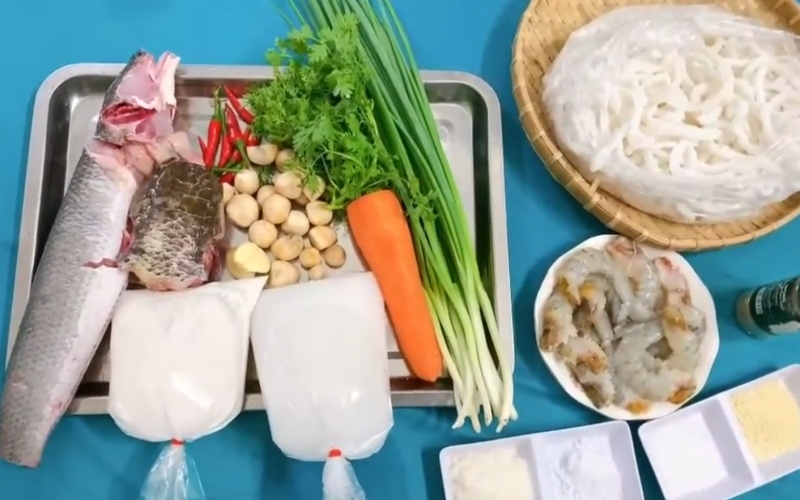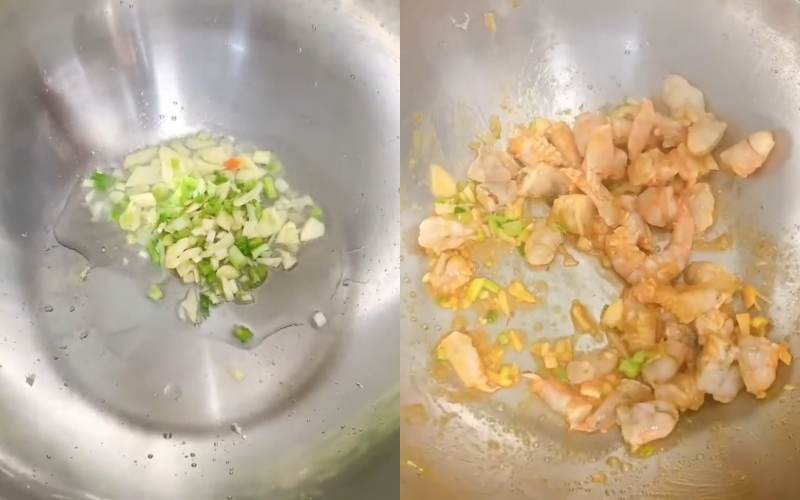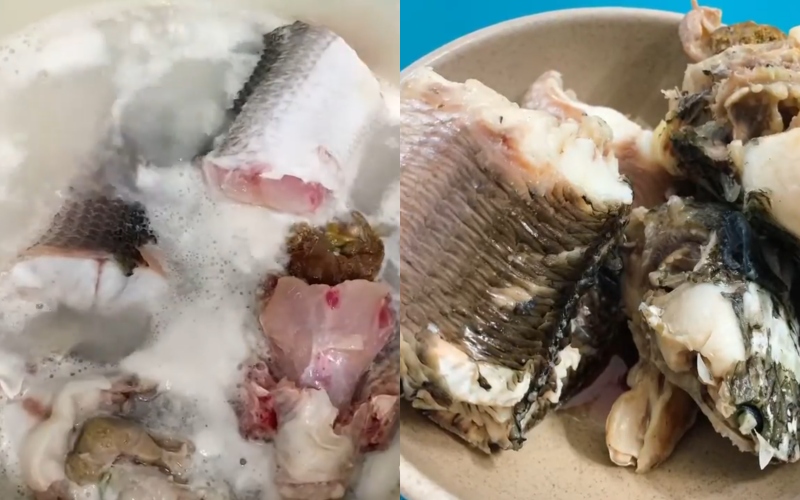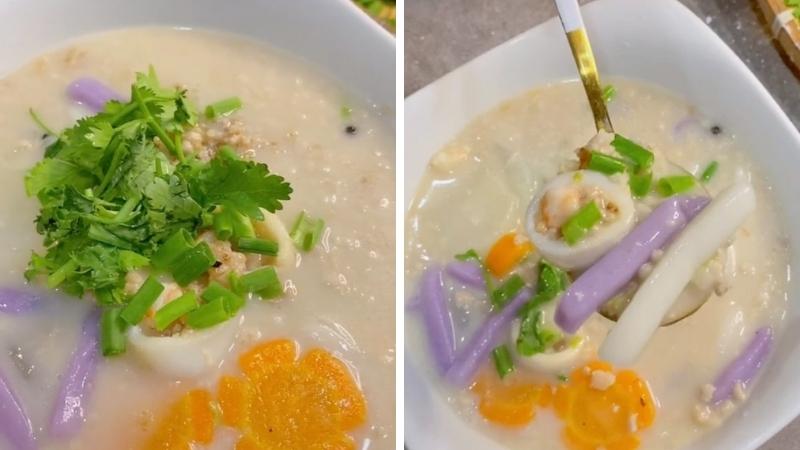Bánh canh is a beloved Vietnamese dish, and today we’re taking it up a notch with a unique twist—bánh canh cá lóc nước cốt dừa. This dish combines the familiar comfort of bánh canh with the delightful flavors of snakehead fish and coconut milk. Follow our step-by-step guide to create this mouthwatering delicacy.
1. Bánh canh cá lóc nước cốt dừa

Preparation
30 minutes Cooking
30 minutes Servings
4 people
Ingredients
 Ingredients for Bánh Canh Cá Lóc Nước Cốt Dừa
Ingredients for Bánh Canh Cá Lóc Nước Cốt Dừa
-
300g bánh canh powder
-
1 snakehead fish (approximately 1 kg)
-
300g shrimp
-
100g shallots
-
1 carrot
-
1 liter of coconut water
-
1 liter of coconut milk
-
Seasonings: fish sauce, sugar, pepper, MSG
-
Equipment: pot, pan, knife, cutting board, bowls, plates, etc.
Tip:
How to Choose Fresh Snakehead Fish
– Opt for live fish with clear eyes, strong swimming abilities, and flexible movements. Avoid those that swim weakly or have cloudy eyes.
– If buying cleaned fish, select ones with bright red gills. Dark brown gills indicate that the fish has been dead for a while, and the meat may not be as fresh.
– Fresh fish meat should be firm, elastic, and not too soft. Gently press the meat with your finger to test its texture.
How to Choose Fresh Shrimp
– Look for shrimp with transparent shells and consistent body color, avoiding any dark patches. The shell joints should be flexible.
– Fresh shrimp usually have slightly curved bodies, naturally firm meat, and closed tails. The head and body should be attached, and the legs firmly connected to the body.
– Avoid overly plump shrimp with wide-open tails, as they may have been injected with chemicals.
How to Choose Fresh Carrots
– Select carrots that are medium-sized and feel solid when held. Fresh carrots have a natural orange color and green stems.
– Avoid carrots that are wilted or have bruised and discolored spots. Gently press the carrot with your finger; if it dents easily, it’s probably spoiling.
How to Choose Delicious Bánh Canh Powder
– High-quality bánh canh powder will be opaque white and slightly soft and elastic, as it’s made entirely from rice or rice flour. It should have a fragrant rice aroma, not a strong chemical smell.
– Avoid bánh canh powder that shows signs of mold or has an odd smell, as it may be past its prime and unsafe to consume.
– Alternatively, you can make your own bánh canh powder at home to ensure its freshness and quality.
Instructions
 Prepare the Snakehead Fish and Shrimp
Prepare the Snakehead Fish and Shrimp
For the snakehead fish, after cleaning and removing the intestines, rub the fish with a small amount of salt for about 3-5 minutes to eliminate any fishy smell and remaining slime. Rinse the fish again, pat it dry, and cut it into your desired pieces.
For the shrimp, peel and remove the black vein on the back. Rinse them and cut into bite-sized pieces.
Tip:
– Instead of using your hands, you can use scissors, a fork, or chopsticks to clean and prepare the fish more efficiently.
– To quickly remove the shrimp veins, make a longitudinal cut on the back of the shrimp and use your hands or a toothpick to pull out the vein.
 Prepare the Other Ingredients
Prepare the Other Ingredients
For the straw mushrooms, trim the ends, rinse them, and soak them in a diluted salt solution for about 5-10 minutes, then rinse again with water.
Peel and rinse the carrot, then cut it into small cubes. Finely chop the green onions and garlic.
 Sauté the Shrimp
Sauté the Shrimp
Heat a pan over medium heat and add 1 tablespoon of cooking oil. Once the oil is hot, add the chopped green onions and garlic and sauté until fragrant.
Add the shrimp to the pan and stir-fry. Season with 1 teaspoon of seasoning powder, 1 teaspoon of sugar, 1/2 teaspoon of salt, and 1/2 teaspoon of MSG. Continue stir-frying the shrimp for about 5 minutes to allow the flavors to infuse the meat.
 Prepare the Broth
Prepare the Broth
In a pot, add 1 liter of coconut water and bring it to a boil over high heat. Once it reaches a near-boil, add the snakehead fish. Season the broth with 1 teaspoon of salt, 1 teaspoon of seasoning powder, 1/2 teaspoon of MSG, and 1 teaspoon of sugar. Continue cooking for about 30 minutes over medium heat to allow the fish to cook through and the broth to become flavorful. Then, remove the fish and set it aside.
 Cook the Bánh Canh Cá Lóc Nước Cốt Dừa
Cook the Bánh Canh Cá Lóc Nước Cốt Dừa
Bring the broth to a boil over high heat and add the carrots. Once the broth boils again, add the straw mushrooms and cook for about 2 minutes. Next, add the bánh canh powder, 1 liter of coconut milk, and the sautéed shrimp.
Continue cooking over high heat until the broth boils again, then adjust the seasoning to your taste. Finally, add a handful of chopped green onions for a fresh touch.
 Delicious Bánh Canh Cá Lóc Nước Cốt Dừa
Delicious Bánh Canh Cá Lóc Nước Cốt Dừa
Your bánh canh cá lóc nước cốt dừa is now ready to be served! Ladle the bánh canh into bowls, top it with the cooked snakehead fish, and garnish with additional green onions. The perfect bowl of bánh canh cá lóc nước cốt dừa should have a broth that’s both creamy and sweet, soft and chewy bánh canh, and tender fish and shrimp infused with the subtle aroma of coconut milk.
2. Bánh canh khoai môn nước cốt dừa

Cooking
30 minutes Preparation
10 minutes Servings
3-4 people
Ingredients
-
500g rice flour
-
100g tapioca starch
-
150g yam
-
Shrimp, squid
-
Coconut milk
-
Carrot, onion
-
A few drops of yam extract
-
Seasonings: seasoning powder, salt, sugar, MSG
 Ingredients for Bánh Canh Khoai Môn Nước Cốt Dừa
Ingredients for Bánh Canh Khoai Môn Nước Cốt Dừa
Instructions
Peel and rinse the carrot and yam, then cut them into chunks. Halve the onion. Finely chop the green onions and cilantro.
Clean the squid and cut it into bite-sized pieces. Peel and devein the shrimp, then remove their heads and tails and set them aside in a separate bowl.
 Prepare the Ingredients
Prepare the Ingredients
In a large bowl, combine 500g of rice flour, 100g of tapioca starch, and 1 teaspoon of salt. Mix well, then gradually add hot water and knead until you form a soft, smooth, and non-sticky dough. Add a few drops of yam extract and mix well.
Once the dough is ready, roll it out into a thin sheet and cut it into strands. Dust the strands with a little flour to prevent them from sticking together.
 Make the Bánh Canh Dough
Make the Bánh Canh Dough
Heat a pan over medium heat and add oil. Once the oil is hot, add the chopped shallots and garlic and sauté until fragrant. Then, add the meat and squid and stir-fry until the meat is no longer pink. Season with 1 teaspoon of seasoning powder and mix well.
 Sauté the Meat and Squid
Sauté the Meat and Squid
In a pot, add 2 liters of water and bring it to a boil. Add the shrimp heads and tails, along with the cilantro roots, and simmer for about 20 minutes. Then, remove them from the broth.
Add the onion, carrot, yam, shrimp, meat, and squid to the broth. Season with 1/2 tablespoon of seasoning powder, 1/2 tablespoon of salt, and 1 tablespoon of palm sugar. Stir well.
Once the ingredients are cooked, add the coconut milk and stir. Finally, add the bánh canh strands and turn off the heat.
 Finish the Dish
Finish the Dish
Your bánh canh khoai môn nước cốt dừa is now ready to be served! This dish



































